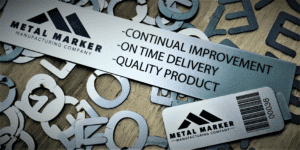Identification solutions range from elaborate designs complete with data matrix codes and logos, to something as simple as a company name and year.
With the New Year upon us, many organizations will update their equipment with 2020 year tags.
Applications for Year Tags
Marking the date or year on a piece of equipment might seem pretty simple, however many organizations rely on this information for a variety of applications.
Servicers or inspectors may be required to mark the date of the most recent inspection. This ensures records are kept up to date, and that the correct service schedule or requirements are being followed. Parts or tools that are inspected on an annual or semi-annual basis are perfect for year tags.
Surveyors often leave survey markers on a site with the current year indicated so that they know when the location was last measured.
Manufacturers of all varieties often mark their finished product with a year or date to indicate when it was produced. This can be key for warranties, as well as informs the end user when exactly the item was produced. Whether your organization produces tools or furniture, marking the year or date can be very important.
Industries
Nearly every industry marks their equipment or other assets with some form of date or year. Some examples include:
- Energy
- Manufacturing
- Warehousing
- Oil & Gas
- Telecommunications
- Many More
Marking Processes
Embossing/Stamping
Most nameplates used for marking a year or other basic information don’t require many colors, a custom logo, or a flashy design. Their role is to convey a simple message. For this type of basic design, embossing and stamping are two of the best marking options.
Embossing uses a die set to raise characters in the metal, whereas stamping recesses the year into the metal. Both types of marking create a highly durable and easy to read nameplate.

As these markings are permanent in nature, they do not need to be replaced on a frequent basis. This may factor in if your organization plans to replace the same tags to fit the current year.
However, for applications such as manufacturers marking original date of production, these nameplates are incredibly effective.
Photo Anodization
Another commonly used process for date and year tags is photo anodization.

The embedding of a design beneath an anodized layer of aluminum means these nameplates can last upwards of 20 years if necessary.
In addition, the photosensitive material allows for full customization. This can include a company logo, barcodes, warning designs, and more.
Screen Printing
There are some organizations which need a more temporary marking for their date or year. A process like screen printing becomes a more viable option.
Topical ink printing is significantly less durable than a physical impression in the material, but it does allow for colored designs.
If durability is not an issue, screen printing provides a highly customizable solution.
Digital Printing (Decals)
For applications requiring a non-metal substrate, decals or labels are another option. These digitally printed labels are considerably less durable than their metal nameplate counterparts.
If the labels will be replaced on a yearly basis anyway, durability is not a major concern. Short of wear or chemical exposure, this type of identification will last long enough to be swapped out for a fresh label on an annual cycle.

Why would you elect to use vinyl labels? They can be more cost effective depending on what your specific design is. Especially if there will be multiple colors involved in the design.
Similarly to screen printing, this is surface level ink, which can produce bright colors. Sometimes labels utilize a different color every year, allowing for very quick identification and sorting.
Wrap-Up
Metal nameplates provide a simple but effective method for marking a year or date on organizational assets. Whether you are manufacturing a product or labeling company equipment, year tags are a useful and durable method.